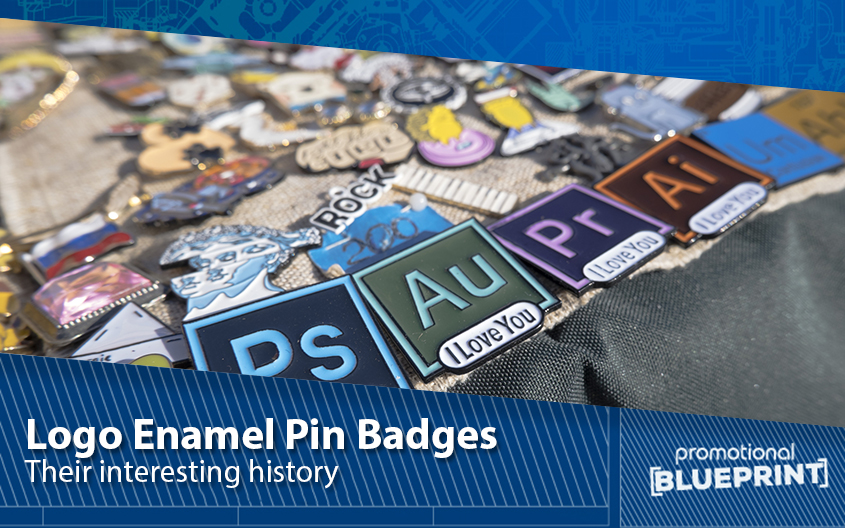
It has been years since custom enamel lapel pins took the world by storm, and even today, their popularity seems limitless. More and more companies, organisations, and businesses are starting to realise their marketing potential. With a reliable partner like GoPromotional by their side, these pins could undoubtedly leave a lasting impression.
As expected, the history of enamel lapel pins is a long and satisfying one. Join us now in exploring their journey to becoming some of the most popular logo items today.
Enamelling 101
The Process
The enamel pin badges we have today aren’t made the same way they were thousands of years ago.
Today, we have enamel paint, which is a solvent-based, glass-free paint that, once dry, forms a vitreous, glass-like shell. Naturally, it’s possible to make the classic versions too (cloisonné hard enamel pin badges). Sadly, their pricing makes them unsuitable for most clients’ marketing budgets.
Vitreous enamel is a type of glass that we can fuse to metal surfaces using intense heat (up to 1450°F). The process of vitreous enamelling includes using the enamel in the form of dry powder (which resembles sand). We apply it with either wet or dry techniques and then vitrify it with heat to form a glass layer over the metal surface.
Though the use of this process is fairly widespread, it is not easy by any means. One of the major problems is that glass, which is made from silica, melts at much higher temperatures than some types of metal.
Thus, we must add something to it to lower its melting point, such as sand, sodium fluoride, borax, and soda ash. For artistic purposes, we can add metal oxides that change the opacity and colour, like gold salts or blue oxide.
The enamel finish that ancient and modern jewellery sport is achieved by coating metal pieces in powdered glass enamel and firing them up in the ovens’ recessed areas. The high temperature in the ovens liquefies the powder, which then lets gravity drag the material over the metal surface. As a result, we get scratch-resistant, durable, smooth enamel.
First Steps and a Groundbreaking Discovery
Egypt artisans and Mesopotamians came up with Filigree around 1,800 BC. This method of craftwork later influenced the invention of the colour inlay technique and the idea of using die lines today to separate colours when making modern enamel pins. Essentially, Filigree is a form of intricate metalwork that entails soldering pieces of wire together to produce various artistic motifs.
Vitreous enamelling, however, can be traced back to the Greeks and Cypriots. They created intricate enamel artwork and jewellery by using lots of heat on raw materials to get glass powder. Then, they would combine that with other minerals to get a certain colour or property.
The first-ever enamel badges, though, were made in China, somewhere around 1271 to 1368 AD. During that period (under the rule of the Yuan Dynasty), the Chinese were creating enamelled pottery with a level of finesse and detail that’s hard to come by today. With the introduction of enamel pin badges, we finally got wearable art.
Popularised by Military and War
Though anyone can wear enamel pins today, they became popular for their use in the military as a way of distinguishing or honouring personnel. As they became more popular, their range of uses expanded to decorating other important figures. With enamel pin badges, we can also express our creativity or even show allegiance to political movements and societal changes.
In wars, these custom badges could also help differentiate between the fighting sides and troops rank and file. A good example of this is The American Civil War. Though they served mainly as a means of identification, the pins could empower soldiers to fight on too.
The tradition of wearing these badges continued even after the war. The survivors wore them with honour to show their association. Years later, future generations started incorporating enamel badges in everyday life as a way of associating themselves with various causes, ideas, and concepts.
Here Comes Advertising
In the early 20th century, enamel pins started to become more associated with modern advertising. The birth of the marketing industry was in line with the established industrial capitalist economy.
The first advertising agency in the world, established around 1840 by Volney B. Palmer, changed marketing forever. Yes, the agency mostly sold space in newspapers to businesses and companies looking to enhance their advertising efforts. But that was the foundation for further expansion of the advertising sector.
Soon enough, various companies were looking to boost their recognition and establish recognisable branding. It may have all started with simple means of promotion through newspapers and via street signs. However, the advertising methods used by companies like Coca-Cola, De Beers, and similar soon expanded to include radio, TV, and, yes, promotional products such as enamel pin badges, mugs, and pens.
Today, we are more than aware of the power a single enamel badge can have. Its ability to carry a message or bold statement around and allow the wearer to show fervent allegiance has made the item a popular marketing choice for businesses of all sizes.
Since they’ve become a part of our everyday life, enamel pins can unite groups of people according to a shared interest. At the same time, they can sell a huge number of products, thus helping companies thrive and making their advertising investment worthwhile.
Related content:
What Makes Printed Badges Effective Promotional Giveaways
The Perfect Enamel Badges for Advantageous Promotion
If enamel badges seem like the right fit for your business, GoPromotional can meet all of your needs and goals. We offer a range of enamel badges in various shapes, colours, styles and sizes.
All you have to do is take your pick — leave the rest to us! With our dedicated team of graphic designers and a host of printing and branding options available, we can ensure your artwork stands out and boost brand awareness on a surprisingly low budget.
Related content:
How to Make the Most Out of Printed Badges
Looking for something different? Browse our full range of branded novelty gifts including button badges, pin badges, and magnets. If for any reason you still can’t find what you are looking for, then simply give us a call on 0800 0148 970 or simply email us today. Together, we’ll make sure your chosen badges fit any event or giveaway you have in mind.






